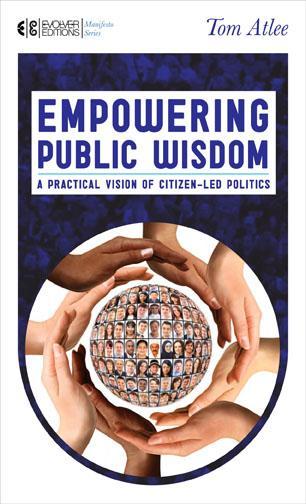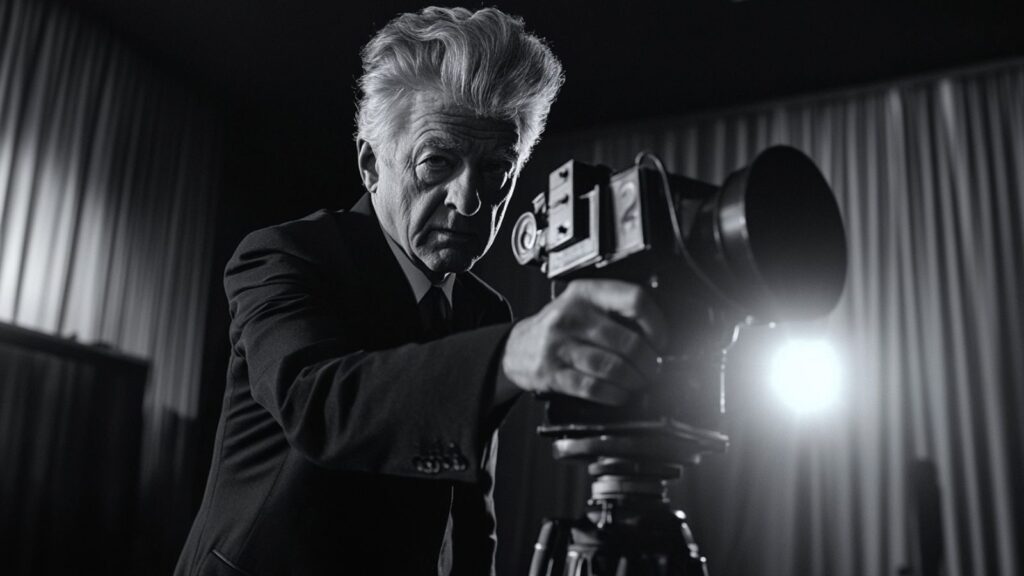The following is the fourth installment of Empowering Public Wisdom: A Practical Vision of Citizen-Led Politics, available from EVOLVER EDITIONS/North Atlantic Books. You can visit the Empowering Public Wisdom homepage here.
CHAPTER 4: Public Wisdom: Its Role, Its Sources, and Its Limitations
We need public wisdom
- to advise our leaders (elected and otherwise);
- to keep officials and others in power answerable;
- to inform and advise individual citizens (especially voters);
- to awaken the public will and power of whole communities;
- to tap into and reflect on the knowledge of experts, while keeping them in their place (they need to be on tap, not on top); and, in some cases,
- to directly make some of the most important decisions our society faces.
In a democracy we, the people, are stewards of the values in our communities and country. We need to be in charge of seeing that those values govern our collective lives. But it is not always clear how those values should play out in specific circumstances, for the common good, among all our diverse neighbors. That’s why we need to talk together about it. That’s why we need to learn from and challenge experts and stakeholders about it. That’s why we need to engage our representatives and other community and national leaders about it.
The public is where the buck stops. The public, as the collective supreme ruler of our democracy, has tremendous responsibility. The public needs to be able to find its own wisdom–public wisdom. This wisdom is something more than all of us individually trying to be wise, to be informed, to be good citizens. It is the wisdom that arises from our informed conversation as we–or groups of our fellow citizens who are as diverse as we are–seek shared understanding, shared solutions, and shared vision to guide the life of our shared community or society into our shared future.
If we can dependably generate real public wisdom among ourselves, there are hundreds of ways we could incorporate it into our politics, our government, and many other aspects of our community and national lives.
The Heart and Engine of Public Wisdom
At the center of our capacity to generate public wisdom are conversations among us–among diverse people and perspectives. All other sources of wisdom–many discussed below–are resources that can inform those conversations. But the bottom line is always us and our conversations, diverse citizens talking together productively.
We’ve all seen and been in conversations about public issues among diverse people and perspectives. Those conversations are usually arguments between each other, among specially selected partisans, or among whoever shows up at a meeting. Even some experts in deliberative democracy claim that deliberation among truly diverse citizens cannot be productive, based on case studies of unfacilitated or poorly facilitated citizen conversations. These are not the kinds of conversations I’m talking about here.
How conversations are set up makes all the difference in the world. This should be no surprise. Design and process are important in all sorts of situations and sectors. Different farming practices generate greater or lesser yields. Different urban arrangements make cities pleasant or alienating. Different arrangements of fuel and flame can cook your dinner or blow up a building. The same truth applies to conversations.
Diverse people talking together can result in a fistfight or a brilliant solution. To a certain extent, it depends on who the people are and how they treat each other. Given the importance of public wisdom, however, we can’t afford to leave the outcomes of important public conversations to the presence or absence of maturity, civility, and enlightened wisdom in the individual participants.
This is where conversational design and facilitation come in. In Congress they have parliamentary procedure and a chairperson to keep things from going crazy. The most widely used parliamentary process in the United States, originally based on Congress’s process, is Robert’s Rules of Order. Pulled together about 140 years ago by an Army engineer, Brigadier General Henry Martyn Robert, it provides a good system for maintaining order and getting work done in a fractious group. But it is not necessarily the best system for generating the kind of wisdom we need to address critical twenty-first-century issues.
Most of us are unfamiliar with what a wisdom-generating conversational process would look like. We’re familiar with the arguments, debates, negotiations, public hearings, and lectures with question-and-answer periods that are common in public places. We’re also familiar with the rambling kinds of conversation and gossip that happen across fences, over dinner tables, in bars, in online chats and blog comments, in phone calls and texting. Some of us have seen some decent deliberations using Robert’s Rules and a few people know how to make and second a motion or an amendment, and to debate and vote according to the rules.
That’s all well and good. But it’s not what I’m talking about.
What Kind of Conversation Generates Public Wisdom?
Conversations that generate public wisdom offer a full spectrum of relevant perspectives that are diverse in terms of both the information made available to the participants and the views of the participants themselves–although the participants are encouraged simply to be themselves rather than represent a particular perspective or constituency. Such conversations also do the following:
- help participants discern and investigate lies and manipulation;
- ensure that every voice is really heard–and that every person feels well heard;
- clearly describe what the participants are being asked to do and how any results will be used;
- engage productively with differences, disturbances, and expressions of emotion;
- help participants step out of oversimplifications to creatively tackle the true complexity of real situations.
None of these things is easy to practice or provide. Our culture does not model these things for us, teach them well, or offer much support for them. But they are possible to create and facilitate, even with people who have little natural capacity to provide them for themselves. There are dozens of ways to do each and every one of them. While specific methods may be better or worse for particular purposes in particular situations, the factors in the above list are among the most vital determinants of how much public wisdom we can produce.
Notice that all of them have to do with helping the whole group work together to take into account everything that needs to be taken into account in order to serve the long-term well-being of their whole community, society, and world.
The Inside Secret
Part of what makes these conversations capable of generating wisdom is that deep inside every person is a realm of genetic, physiological, emotional, mental, social, and often spiritual common ground that they share with every other human being.
In other words, because we are all human beings–and despite all our differences–we have a tremendous amount in common. Virtually all of us have experienced pleasure and pain, joy and anger, birth and death, loving and hating, hunger and satisfaction, beauty and ugliness, and freedom and oppression. Most of us feel more at home and at peace in situations where we are appreciated for who we really are, where we can contribute in real ways, where we feel safe and respected, and where our needs are understood and met. Yes, we have different cultures, classes, genders, political opinions, abilities, races, and experiences. But somewhere deep inside, we know what it feels like to be a human being in this world. And we can reconnect to that knowledge in quality conversation with others.
Much of this commonality of experience is limited to our common humanness. But other aspects arise from our relationship to other forms of life, especially our expressive hairy cousins, the other mammals: the cats, dogs, chimpanzees, horses, polar bears, and all the rest. Because of this we can experience a certain empathy and resonance with animals and plants–some of us more than others, but all of us to some degree. We know what it feels like to be tortured or pleasured, even to an animal. Research recently disclosed the existence of “mirror neurons”: because most of us have these in our brains, when we see a person or animal being hurt, part of us feels the same pain they are feeling. This is natural compassion.
To some degree this felt and factual commonality connects us to all other forms of life, for we are living beings. We share the earth as our living space: the sky above, the ground below, the rhythms of seasons and biological functions, the flowing of water and air (including the vital cycles of oxygen and carbon dioxide), and the forests, caves, and structures that are homes to living beings of all kinds. All these things we share with all life. Even in our manufactured worlds of concrete, glass, metal, plastic, abstractions, and special effects, these natural realities call to us and can move us in deep ways. We can even imagine– however inexactly–what life might be like for an ant or a crow.
Some even say we share a common mind; a collective consciousness; a shared spirit, soul, or “ground of being.” Regardless of how any of these may or may not be true, we needn’t go any further than our physical, biological, and social creatureliness to realize our kinship and commonality. This realization can be a profound source of wisdom because it emerges from the truth of our fellowship with each other and all life, which, when we take it seriously, guides us to seek long-term benefits for all. It can call us back to these realities when we get lost in artificial divisions and disconnections.
When we are grounded in this deep-shared experience more than in our different ideologies, cultures, and political positions, we rediscover our common humanity and aliveness. That prepares us to identify and articulate the common good, to believe that it matters and is possible, and to feel inspired to bring it about in the real world.
By giving us the challenge to pursue the common good in the face of all our differences, and then helping us to really hear each other, powerful conversational approaches lead us progressively into what I call the core commons of our life. Going there stimulates a shift in us, a shift that is essential to our individual and collective discovery of our wisdom and power as We the People. We realize that so much more and better is possible than ever before.
Some people encourage me to talk more about the spiritual dimensions of high-quality conversational approaches. For me, though, there isn’t much to say beyond what I’ve said here. Whatever connects us to our core commons– the heart and soul of our connection to each other and the world–is spiritual to me. And high-quality conversation draws us into that connection in a very clean and simple way, with no need for any spiritual language or sectarian or esoteric beliefs or practices.
So this is the fundamental tool: diverse people interacting in conversations that help them ground in their natural common humanity and life. When we are successful at that, we are well on the road to group wisdom.
But there’s more.
Seeking Greater Wisdom
As we pursue public wisdom we should always ask: what else can we do to make these conversations more wise? In particular: how can we reach beyond our limited ways of thinking? Our society works very hard to put us in boxes and frames and then to convince us that they are real and complete, that we should stay in them and never think of stepping outside. But we must leave them if we wish to see the bigger pictures that will give us wisdom. Here are some ways to do that:
Creatively engage diverse forms of intelligence. Help people use their full human capacities–including reason, emotion, intuition, humor, and movement, as well as aestheticand spiritual sensibilities, capacities, and activities.
Different people have different ways of learning, engaging, and expressing themselves, and these differences are among the most valuable to respect and use creatively.
Consult global wisdom traditions and broadly shared ethics. Ethical principles common to most major religions and philosophies provide time-tested wisdom. We can augment these with what humanity has learned more recently through science and global dialogue about what serves human needs and happiness. Two good resources for this are the Council for a Parliament of the World Religions and the Universal Declaration of Human Rights. Nonviolent Communication and Chilean economist Manfred Max-Neef provide deep insight into universal human needs. (Note: It is fine for conversational participants to be individually informed and guided by their own faith traditions and practices. It is also often useful for spiritual or religious groups to bring prayer, meditation, or other sacred practices into their dialogues and deliberations. But there is good reason for the separation of church and state. So in inclusive democratic conversations pursuing the common good, we need to stick to broadly held ethical principles, like the Golden Rule, which shows up in virtually every major religious tradition. If a spiritually deepening practice is desired in the course of a public conversation among diverse citizens, simple silence for a few minutes can serve well, across virtually all traditions.)
Seek guidance from natural patterns. Wisdom is embedded in nature, in organisms, in natural forms and processes, and in the dynamics of evolution, providing a vast reservoir of insight and know-how tapped by today’s scientists and engineers, often standing on the shoulders of ancient tribal and agricultural cultures. Among the good resources on this are biomimicry, the study of how nature solves engineering problems, and permaculture, the study of how to design fruitful natural systems from scratch. Both sciences offer many insights into how we can enhance community and societal health.
Apply systems thinking. Systems thinking can help people understand underlying causes and take into account how things are interrelated, how wholes and parts influence each other through power relations, resonance, feedback dynamics, flows, motivating purposes, and life-shaping narratives, habits, and structures. A good resource on this is the work of Donella Meadows. Her many articles and her book Thinking in Systems are compelling and easy to understand.
Think about the big picture and the long term. Wisdom grows as we step out of limiting perspectives to understand (and creatively use) histories and energies from the past, current contexts and trends, future ramifications and needs, larger and smaller scales, and other mindexpanding perspectives. Briefing materials, metaphors, stories, and visual presentations can introduce participants to such larger contexts. Exercises can invite participants to step into expanded views–using role-playing, for example, to step into others’ shoes, or visioning to step into the future, or brainstorming to step into wildly creative perspectives and possibilities.
Seek agreements that are truly inclusive. To the extent lots of people contribute to, engage with, and believe in an agreement, that agreement will wisely address what needs to be addressed and will get implemented well. At the very least, don’t be satisfied with mere majority voting, which depends on majority domination and leaves a significant minority dissatisfied. Dig deeper into shared values and needs. Every step of the way, seek out people’s concerns and take them seriously to see if they can be satisfied in ways that move group support closer to a supermajority (67 percent or more) or a consensus or breakthrough that all participants are pleased with. Note that shallow, reluctant agreements and compromises–as well as agreements based on deals irrelevant to the issue being discussed– may get results, but those results won’t be wise. Compromises and similar strategies arise from the group’s inability to actually address what needs to be addressed to produce a truly inclusive resolution of the issue–namely, their differences and the important realities hidden within those differences.
Release the potential of hidden assets and positive possibilities. In addressing a situation, we cover more ground and inspire more support and participation if we notice and creatively engage energies and resources that already exist in the situation and tap the power of people’s aspirations, which often show up at the rough edges, on the margins. Among the good resources for this are Appreciative Inquiry, Positive Deviance, Asset-Based Community Development, and Dynamic Facilitation, each of which has its own powerful approach for evoking positive possibilities from problems and conflicts. (See appendix 1 for more information on these and other processes mentioned in this book.)
Encourage healthy self-organization and learning. Any situation or system contains people, experience, ideas, and capacities that can help those involved solve problems and self-organize in healthy ways–if they are invited and supported in doing so. Here are some ways to do this: Create an atmosphere of participation and collaboration. Ask powerful questions. Elicit crowdsourced ideas and resources. Offer incentives. Play games designed to bring out and explore the dynamics of the situation. Bring vibrant, empowered democracy into it. Convene World Café conversations (see page 112) and Open Space conferences (see page 114) to provide juicy approaches to help a group or community explore and solve its own problems and pursue what the people involved really want to do together. (These two powerful methods are particularly easy to convene and facilitate.)
Make information more accessible and meaningful as knowledge. As noted earlier, information presented to citizen deliberators should be diverse and true. In addition, both the information and its significance should be readily understandable. Simple language, narrative forms, and meaningful visual and audiovisual presentations can help tremendously. The work of Edward Tufte explores how to present data in meaningful visual ways, and argument mapping and framing for deliberation cover the presentation of diverse perspectives in ways that make them easy to understand and compare. Journalists can also help clarify the larger stories that make useful meaning out of isolated pieces of data.
Do it again. Redundancy and iteration are powerful patterns in nature. Redundancy means having more than enough of something. Having an extra hand, arm, foot, eye, lung, and ear not only means that they can work together but that if we lose one, we still have the other. Asking three friends about a car repair shop tends to produce more useful information than asking only one friend. Doing three comparable public deliberations and comparing the results is more likely to produce wisdom than doing only one. Iteration means doing things again, informed by feedback from earlier attempts. Wise people notice the results of their actions and act accordingly, correcting their errors. Likewise, a one-time public process can generate a certain amount of public wisdom, but doing a similar activity every three months or every year increases the chance that each new iteration will learn from the previous ones and from the real-world effects of their earlier recommendations.
No Guarantees, but Good Chances . . .
Our definition of public wisdom is based on the obvious and painful fact that when we fail to take something important into account, it comes back to bite us–perhaps not immediately, but sooner or later, in one way or another. Foolish, ill-considered decisions tend to leave us with worse problems than we had before. Wiser decisions tend to create fewer bad outcomes because they take into account more of what–and who–is most relevant and important.
In practice, though, we don’t really know how wise a decision is until long after it is implemented. After all, it is the long-term results that make it wise, by definition. The more “wicked” the problem, the more we get to face this sobering reality; the problem’s complexity makes it that much harder to predict what will happen. To really know whether a decision is wise, we have to wait and see.
However, just because we can’t be certain a decision is wise at the time it is made, doesn’t mean we’re helpless. There is much we can do before, during, and after we make a decision to make it more likely that it will be wise. Our definition of public wisdom–considering together what actually needs to be taken into account to produce long-term broad benefits–implies guidelines and approaches like those described in this chapter. These practices lead us to consider “more of the whole.” So the more of them we incorporate into our citizen engagement, politics, and governance–and the more effectively we do each one–the more likely it will be that we will generate public wisdom.
?













